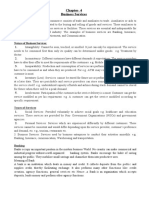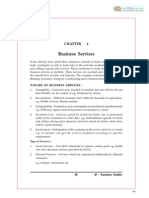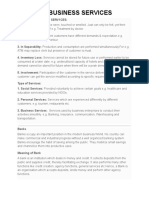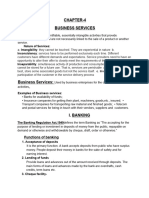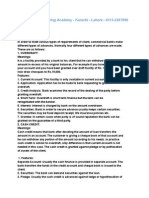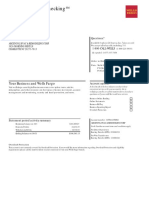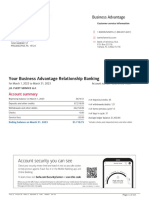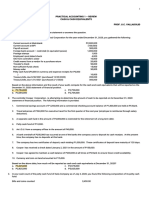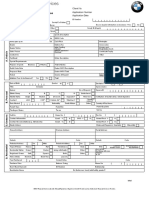BUSINESS SERVICE
Business services are those services which are used by business enterprises for the production
or sale of goods and services. Goods: are those physical or tangible (which can be touched)
products which are capable of being delivered to the purchaser and involves the transfer of
ownership from the seller to the purchaser. e.g., a toy, a movie CD, etc. Services: are
identifiable and intangible activities that provide satisfaction of wants. Service is an act which
can't be taken home, but its effect can be surely be carried. e.g., services of a doctor, a
beautician, etc. In today's competitive world, business enterprises are much dependent on
business services, as these services help the enterprises to carry on their activities smoothly.
❖ Nature of Services:
• Features: Services are explained by five I's namely; Intangibility, Inconsistency,
Inseparability, Inventory and Involvement.
• Intangibility: Services are intangible i.e., they cannot be touched. They can only be
experienced.
• Inconsistency: The second important characteristic of services is inconsistency.
• Inseparability: Production and consumption of services take place simultaneously. It is
possible to manufacture a chair today and sell it later but in case of services it has to be
simultaneous.
• Inventory: Services have no inventory as they can't be stored.
• Involvement: Consumer gets involved in production of services and gets the opportunity to
get the services modified as per his specific requirement.
❖ Types of Services: • Social Services: These services are provided voluntarily to achieve
certain goals. For example, health care and education services provided by NGOs.
• Personal Services: Services which are experienced differently by different customers are
called personal services. For example, tourism, restaurants etc.
• Business Services: Services used by business enterprises for the conduct of their business
activities. For example, banking, insurance, communication, warehousing and transportation.
(1) Banking: Bank means a company accepting deposits of money from public (for lending
and investment), repayable on demand and withdrawal by cheque or otherwise. Types of
Banks:
❖ Commercial Bank: A commercial bank is that financial institution which accepts deposits
from the public and offers loans for the purpose of consumption or investment. These banks
pay interest on deposits and charge more interest on loans, thereby, enabling them to earn
profits. They are governed by Indian Banking Regulation Act, 1949. Types of Commercial
Bank:
• Public Sector Bank: They are owned by government. They are 20 in numbers. E.g. SBI,
PNB, C.B., etc.
• Private sector banks: These banks are owned by private promoters HDFC, ICICI, etc.to
emphasize more on profitability.
�• Foreign banks: They are owned and managed by foreign promoters. For example; Citi
Bank, Standard Chartered.
❖ Functions Of Commercial Banks:
• Acceptance of Deposits: Banks accepts deposits from the customers. It is considered as the
borrower of money. As borrower it pays interest on the amount deposited. The various types
of accounts in which money can be deposited are discussed ahead in the topic.
• Lending of Funds: Second major activity of commercial bank is to provide loans and
advances, out of the money received through deposits. The various forms in which banks lend
money are also discussed ahead.
• Cheque Facility: The cheque is the most developed credit instrument which helps in the
withdrawal of deposits. It is a convenient and inexpensive medium of exchange. There are
two types of cheques. (a) Bearer Cheques Which are cashable at bank counters, and (b)
Crossed Cheques Which are deposited in payee's account.
• Remittance of Funds: Commercial banks provide the facility of transfer of funds from one
place to another with the help of bank drafts, pay orders or mail transfers, on nominal
commission charges.
• Allied Services: The banks also provide services relating to bill payments, locker facilities,
underwriting services, buying and selling of shares and debentures on instructions and
personal services, like payment of insurance premium, collection of dividends, etc.
❖ Types Of Commercial Bank Accounts: (2) The primary function of commercial banks is to
accept deposits. The customers can deposit their money in following types of bank accounts
• Savings Account: Savings deposit account is meant for individuals who want to save some
amount of money out of their incomes. In this account, customers can deposit money as per
their ease and they can also withdraw money by means of a cheque or a withdrawal slip as
and when they need it. The amount deposited in a savings account bank is referred to as the
demand liability of bank.
• Current Account: Such accounts are opened by businessmen by making an initial deposit of
₹ 5,000 in the bank. There are no restrictions on the amount deposited or the number of
withdrawals made. Therefore, it is also referred to as a running and active account.
• Recurring Deposit Account: In such accounts, the account holder is required to deposit a
specified sum of money every month. They are also termed as cumulative time deposits. The
period of account may range from 12 months to 10 years.
• Fixed Deposit Account: In such accounts, a lump-sum amount is deposited for a specified
time period which can range from fifteen days to five years. This deposit is repayable after
the expiry of this fixed period. Fixed deposits are also called time deposits or long-term
deposits.
• Multiple Option Deposit Account: It is a combination of savings account and fixed deposit
account. In this account, the depositor can enjoy the liquidity of saving account and rate of
interest of fixed deposit account. In this account, the depositor gives standing instruction to
�the bank to convert the balance in his savings account into a fixed deposit, if it crosses a
given threshold limit.
❖ Lending of funds by commercial banks: The second primary function of commercial banks
is to lend funds to their customers. The bank can lend money through the modes specified
below
• Bank Overdraft: It is a temporary arrangement under which a depositor is allowed to draw
by cheque more than the amount to his credit upto a specified limit. Overdraft is granted
when the borrower has a current account with the bank. This facility is provided against the
security of some assets or on the personal guarantee of the borrower. Interest is charged on
the exact amount overdrawn by the current account holder.
• Cash Credits: It is a revolving credit arrangement wherein the bank allows the borrower to
borrow money upto the specified limit. The bank places the specified amount to the credit of
the borrower's bank account. The borrower withdraws money as and when required. Interest
is charged only on the amount actually withdrawn by the borrower. Cash credit limit is
decided by the bank on the basis of the borrower's assets and personal reputation.
• Discounting the Bills of Exchange: The customers who enjoy a good goodwill can get their
trade bills discounted by the bank. The banks credit the amount of the trade bill to the
customer's account after deducting discount charges for the period until the due date.
• Term Loans: Term loans are granted by banks for a fixed period of time, against the
security of an asset. This loan can be repaid in monthly quarterly/half yearly/yearly
instalments.
• Consumers Credit: Bank grant loans to consumers to purchase houses, cars, computers, etc.
The amount of loan is repaid in Equal Monthly Instalments (EMI).
❖ Services provided by commercial banks: Banks offer a wide range of services to their
customers. These services are referred to as “banking services' Following are the description
of such services.
• Issue of Bank Draft: A bank draft is a type of cheque which is drawn by a bank either on its
own branch or on another bank. In order to remit money through a bank draft, a person first
obtains the bank draft from the bank, fills in a form and pays the amount of the draft along
with the prescribed commission. He, then sends the bank draft to the receiver by post. The
receiver then deposits it in his bank. The bank collects the payment from the concerned bank
and credits it to the customer's account.
• Pay Order or Banker's Cheque: It means the bank draft which is payable within the city or
town. It may be called as a local bank draft. Banks issue pay orders for local use and issue
bank drafts for outstations. The commission charged for a pay order is lesser as compared to
bank draft.
• Real Time Gross Settlement (RTGS): It is a fund transfer system under which transfer of
funds takes place from one bank to another on a Real Time and Gross basis. Web Settlement
on 'Real Time' means that there is no waiting period and 'Gross' settlement means the
transaction is made on one-to-one basis. It is the fastest possible system for transfer of
money.
�• National Electronic Funds Transfer (NEFT): It is a countrywide system by which an
individual, firm or company can electronically transfer funds from any bank branch to
another individual, firm or company having an account with any other bank branch in the
country.
• Other Services: Banks also provide e-banking services to its customers.
❖ e-Banking: e-Banking or electronic banking is a service provided by banks that enables a
customer to conduct banking transactions, such as checking accounts, paying bills etc over
the internet, using a personal computer, mobile telephone or handheld computer. e-Banking
includes a range of services like Electronic Funds Transfer (EFT), Automated Teller Machine
(ATM), Electronic Data Interchange (EDI), Credit Cards and Electronic or Digital Cash.
Benefits of e-banking to Customers are:
• e-banking provides 24 hours, 365 days a year services to the customers.
• It lowers the transaction cost and provide unlimited access to the customers
• It inculcates a sense of financial discipline and promotes transparency.
• Customers can make the transactions from office, home or while travelling. Benefits of e-
banking to Bank are:
• e-banking provides competitive advantages to the bank.
• It provides unlimited network to the bank.
• It also helps in reducing the burden of bank by establishing the centralised database.
❖ Digital Payments: Digital payment can be defined as a way of paying for services or goods
via an electronic medium without the use of cash or cheque. It is also known as electronic
payment system or e-payment system. Types/ Methods of Digital Payments:
• Banking Cards: These cards have been the most used digital payment modes till now. Credit
cards, debit cards and prepaid cards are the main types of cards with authentication of PIN
and OTP for severe payments. RuPay, Visa and Master cards are some of the example of card
payment systems. Banking cards can be used for online purchases, in digital payment apps,
point of sale machines, online transactions, etc.
• Unstructured Supplementary Service Data (USSD): The innovative payment service *99#
works on USSD channel. This method can be used to carry out mobile banking transactions
without the use of mobile internet data. This service can be used to initiate fund transfer and
to make balance queries. • Aadhaar Enabled Payment System (AEPS): It is a way to make
financial transactions from the bank account with the help of your biometric authentication.
AEPS can be used for all banking transactions such as balance enquiry, cash withdrawal, cash
deposit, payment transactions, etc.
• Unified Payment Interface (UPI): UPI android apps enable all bank account holders to send
and receive money from their smart phones without the need to enter bank account
information.
� • Mobile Wallet: It is a virtual wallet that stores payment card information on a mobile
device. Mobile wallets are convenient way for a user to make in-store payments and can be
used at merchants listed with mobile wallet service provider.
• Point of Sale (PoS): Terminals It refers to those machines that are installed at all stores
where purchases are made by customers using credit/debit cards. It is usually a hand held
device that reads banking cards.
• Internet Banking: It refers to the process of carrying out banking transactions online.
Internet banking is usually used to make online fund transfers via NEFT (National Electronic
Fund Transfer), RTGS (Real Time Gross Settlement) or IMPS (Immediate Payment
Services).
• Mobile Banking: Mobile banking is referred to the process of carrying out banking
transactions through a smartphone. The scope of mobile banking is only expanding with the
introduction of many mobile wallets, digital payment apps, 13 UPI and own apps of banks.
• Bharat Interface for Money (BHIM) App It is a mobile app developed by National
Payments Corporation of India (NPCI), based on Unified Payment Interface (UPI). The app
supports all Indian banks through immediate payment service infrastructure and allows the
user to instantly transfer money between bank accounts of any two parties. Other Types of
Banks: Apart from commerical banks, other specialised types of banks are also there. These
are
❖ Cooperative Banks: These banks have a common ownership and generally provide short
term loans to the agricultural sector. They are formed by a group of individuals to extend
credit to their members. These are governed by State Cooperative Societies Act.
❖ Specialised Banks: These banks are established to cater to certain specific needs of the
target groups. Foreign exchange banks, industrial banks, etc are examples of specialised
banks. These banks provide financial aid to industries, heavy turnkey projects and foreign
trade.
❖ Central Bank: This bank is the apex bank of the country. It supervises and controls the
functioning of other banks. It plays an important role in the banking and monetary system of
the country. Reserve Bank of India is the Central Bank of our country. Insurance: It is a
contract where one party who takes the responsibility of the risk of other party in exchange of
some fixed amount which is called premium.
❖ Principles of Insurance:
• Principle of the utmost good faith: It means that no material or important facts should be
concealed by both the parties to the insurance contract.
• Principle of insurable interest: It means that there must be such a relationship between the
insured and the subject matter of insurance that the insured stands to benefit by its safety and
to loose by its loss.
• Principle of Indemnity: It means that the insured person can get only the compensation
against actual loss and he cannot make profit out of it.
�• Proximate causes: When the loss is the result of two or more causes, the proximate cause,
i.e., the direct, the most dominant and most effective cause of loss should be taken into
consideration. The insurance company is not liable for the remote cause.
• Principle of subrogation: It means that if the insured compensate the insured person then all
the rights related to the subject matter of insurance get transferred to the insurer.
• Principle of contribution: If the same subject matter, except life is insured by more than one
person, then the actual loss will be shared by all the people.
• Principle of mitigation: It means that the insured should try to minimise the loss of the
subject matter of the insurer even if it is insured.
❖ Types of Insurance:
• Life Insurance: Life Insurance is defined as a contact in which the insurer, in consideration
of a certain premium, either in a lump sum or by other periodical payments, agrees to pay to
the assured, or to the person for whose benefit policy is taken, the assured sum of money, on
the happening of specified event contingent on human life or at the expiry of certain period.
❖ Main Elements of Life Insurance Contract are
• It must have all the essentials of a valid contract.
• The contract of Life Insurance is a contract of utmost goods faith.
• In Life Insurance, the insured must have insurable interest in life insured.
• It is not a contract of indemnity.
❖ Types of Life Insurance
• Whole Life Policy: Under this amount payable will not be paid before the death of the
assured. It will be payable to legal heir (s).
• Endowment Life Insurance: Under this sum assured is given in full payment after
completion of policy / death of insured, whichever is earlier.
• Joint Life Policy: When a policy taken up by two or more persons, it is called joint life
policy.
• Annuity Policy: When policy money is payable monthly, it is called annuity policy.
• Children Endowment Policy: It is a policy for children to meet higher education or marriage
expenses.
❖ General Insurance
• Fire Insurance: It is a contract whereby the insurer, in consideration of a premium paid,
undertakes to make good any loss or damage caused by a fire during a specified period upto
the amount specified in the policy.
• Marine Insurance: It is an agreement whereby the insurer undertakes to indemnify the
insured in the manner and to the extent thereby agreed against marine losses. It provides
protection against any loss by marine perils or perils of the sea.
�• Health Insurance
• Vehicle Insurance• Burglary Insurance and • Cattle Insurance • Crop Insurance • Fidelity
Insurance • Ship Insurance • Cargo Insurance • Freight Insurance
Communication: Communication services are responsible for the transmission of required
information to the concerned parties. It is communication due to which business is able to
establish a link with outside world viz., suppliers, customers, competitors, etc and able to
share ideas and information. Communication services should be fast, accurate and effective in
order to meet the demands of business world. Postal and telecom are the two main
communication services which help a business.
❖ Postal Services: The Postage and Telegraph Department provides various postal services
throughout the country. The Government of India has divided the whole country into 22
postal circles. These circles manage the day-to-day working and perform various services
through post offices, subpost offices and branch post offices. Postal department provides
various facilities which are explained below.
❖ Financial Services: Financial services were initiated in the post offices due to lack of
banking facilities in the country. The details of such facilities are as follows.
• Public Provident Fund (PPF): Any adult residing in India can open a Public Provident Fund
Account in a post office and in specified banks. The account holder is required to deposit
every year an amount ranging between 500- 1 lakh in his PPF account. Interest is credited
every year at the prescribed rate.
• Kisan Vikas Patra (KVP): It is a saving scheme in which invested money is doubled in eight
years and seven months. The ‘Kisan' in Kisan Vikas Patra does not mean that it is only for
farmers. It is meant that the revenue mobilised by this scheme will be used by the
government in welfare schemes for farmers.
• National Savings Certificate (NSC): One can buy NSC from the post offices. The term of
NSC is five years. A new NSC with a maturity of ten years has been introduced. The
principal amount alongwith accumulated interest is paid on maturity.
❖ Mail Services: The postal department provides facilities for transmission of post cards,
inland letters, parcels, etc from one place to another. Various types of mail services offered by
the Postand Telegraph Department are described below
• Registered Post: It is a postal facility under which it is ensured that the mail is either
delivered to the address or it comes back to the sender by paying registration charges. The
registered mail is marked ‘Registered s Post' on its face, to differentiate it from the ordinary
mail.
• Parcel Post Parcels: of specified size and weight can be sent to domestic and international
locations under this service. Postal charges for parcels depend on the weight of the parcel and
are reasonably low. Charges for foreign parcel post are higher than that for inland parcel post.
• Speed Post: This service is designed for very fast delivery of mail. The Post and Telegraph
Department guarantees that all internal mail received upto 5 pm at the specified post offices
�will be delivered within 24 hours. If it fails to do so, the extra fee charged for this service will
be refunded.
❖ Other Services Offered by Post Office
• Greeting Post: Through post offices, greeting cards can be send to friends and relatives on
different occasions. • Media Post: Business units can send postcards envelopes, etc to their
present and prospective customers to build up their brand.
• Direct Post: Business units can send addressed or unaddressed direct post to advertise their
business.
• e-Bill Post: Customers of BSNL, Airtel etc. can deposit their bills at the concerned post
office.
• International Money Transfer: A collaboration between Postal Dept. and Western Union
Financial Services, USA has enabled customers to remit money to 185 countries through a
post office.











